Posts Tagged ‘nutrition’
Monday, June 6th, 2011
Berries are some of the most healthy foods, and summer is the season of the berry. Besides being delicious, berries are low in fat and calories, but high in fibre, vitamins, minerals, and antioxidants, these not only contribute to overall health, but may even help prevent cancer and heart disease. They are more affordable in summer, being in season and thanks to the freezer, we can have the advantages of berries year-round.
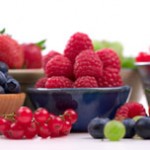
Ideas for Serving Berries
Most berries like strawberries, blueberries and raspberries are sweet enough to be served just as they are; however, here are some more ideas:
- Add strawberry slices to a bowl of whole grain cereal
- Sprinkle blueberries on a salad
- Stir fresh raspberries into yoghurt
- Combine frozen berries with bananas and low-fat milk to make a smoothie
Tags: 5 a day, berries, calories, carlow, fruit, healthy eating, kilkenny, low fat, nutrition, nutritional concepts, snack, summer, vitamins and minerals
Posted in General | Comments Off
Monday, May 23rd, 2011
GET FIT & LOSE WEIGHT FOR CHARITY
Nutritional Concepts is proud to support this
8 Week Charity BOOTCAMP at Killerig Resort!!
- Full weight loss & nutrition programme
- Motivational support
- Professional experienced instructors
- Regular weigh-ins
- Prizes for most weight lost & money collected.
STARTS 1st WEEK IN JUNE!


Tags: activity, bootcamp, carlow, charity, diet, dietitian, healthy eating, lose weight, nutrition, nutritional concepts, Sport
Posted in General, Sport | Comments Off
Monday, May 9th, 2011
Benefits of Quitting Smoking
Quitting smoking may well be the single most important thing you can do to improve your health, your body feels these benefits almost immediately.
- After 20 minutes your blood pressure and pulse return to normal.

- After 24 hours your lungs start to clear.
- After 2 days your body is nicotine-free and your sense of taste and smell improve.
- After 3 days you can breathe more easily, and your energy increases.
- After 2 to 12 weeks, your circulation improves.
- After 3 to 9 months coughs, wheezing and breathing improves.
- After 1 year your heart attack risk is half that of a smoker.
- After 10 years your lung cancer risk is half that of a smoker.
|
Irish Cancer Society (2011)
Will I Gain Weight if I Quit Smoking?
Not everyone gains weight when they stop smoking. You can control your weight while you quit smoking by making healthy eating and physical activity a part of your life. Although you might gain a few pounds, don’t forget that you have quit smoking and taken a big step toward a healthier life.
How to Reduce Weight Gain After Quitting Smoking
Get regular moderate intensity physical activity. Regular physical activity may help you avoid large weight gains when you quit smoking. It may help you look and feel good, and fit into your clothes better. You will likely find that you can breathe easier during physical activity after you quit smoking. Try to get 30 minutes or more of moderate-intensity physical activity on most days of the week, preferably every day.
Diet Advice After Quitting Smoking
Having more high fat, sugary snacks and alcoholic drinks may lead to large weight gains when you quit smoking. The ideas below may help you make healthy eating and drinking choices as you quit smoking.
- Do not go too long without eating. Being very hungry can lead to less healthy food choices.
- Eat enough at meal times to satisfy you.
- Choose healthy snacks, such as fresh fruit or canned fruit in juice (not syrup), unsalted popcorn or fat-free yoghurt, when you are hungry between meals.
- Do not deny yourself an occasional treat.
Tags: activity, calories, carlow, diet, fat, healthy eating, kilkenny, nutrition, nutritional concepts, quit, smoking, weight gain
Posted in General | Comments Off
Monday, April 25th, 2011
Easter time is here again and our thoughts turn to eggs. Here is some information on eggs of the healthier variety.
Eggs are a good source of protein and contain vitamins and minerals. They are also easy to prepare.
How many eggs?
There is no recommended limit on how many eggs people should eat. Eggs are a good choice as part of a healthy balanced diet. However, remember that it is important to eat a variety of foods each week to get the wide range of nutrients we need.
Eggs are a good source of: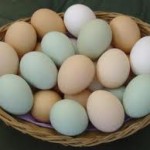
- protein
- vitamin D
- vitamin A
- vitamin B2
- iodine
Eggs can make a really healthy meal. Why not try one of these for your breakfast, lunch or evening meal:
- Spanish omelettes served with steamed vegetables or a salad.
- Poached or scrambled eggs and baked beans served on wholegrain toast.
- Boiled eggs chopped into a summer salad.
Fried eggs are higher in fat than boiled, poached or scrambled eggs, but there is nothing wrong with having them occasionally. If you do want a fried egg, use oil that is high in unsaturated fat such as sunflower oil.
Eggs and cholesterol
Eggs contain cholesterol and high cholesterol levels in our blood increases our risk of heart disease.
However, the cholesterol we get from our food – and this includes eggs – has less effect on the amount of cholesterol in our blood than the amount of saturated fat we eat. So, if you are eating a balanced diet you only need to cut down on eggs if you have been told to do so by your GP or dietitian. If your GP has told you to watch your cholesterol levels, your priority should be cutting down on saturated fats.
Tags: calories, carlow, cholesterol, diet, easter, eggs, fat, healthy eating, kilkenny, low fat, nutrition, nutritional concepts, saturated fat, vitamins and minerals
Posted in General | Comments Off
Monday, April 11th, 2011
Ingredients
For the carrot cake: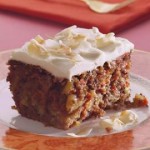
150 g dark brown soft sugar
2 large eggs
120 ml sunflower oil
200 g wholemeal self-raising flour
1½ level teaspoons bicarbonate of soda
3 rounded teaspoons mixed spice
Grated zest 1 orange
Juice of half an orange
200 g carrots, peeled and coarsely grated
275 g chopped dates
For the topping:
250 g low fat soft cheese
20 g icing sugar
2 teaspoons vanilla extract
Grated zest of one orange
1 level teaspoon ground cinnamon
Method
Pre-heat the oven to 170°C.
Line the base of a deep non-stick square cake tin (measuring 8 x 8 inches) with greaseproof paper.
First beat together the sugar, eggs and oil in a bowl for a couple of minutes until smooth.
Now sift together the flour, bicarbonate of soda and the mixed spice into the bowl. Mix well and then fold in the orange zest, orange juice, dates and carrots.
Then pour the mixture into the tin and bake in the centre of the oven for 35 to 40 minutes. Once cooked, remove from the oven and leave to cool on the side.
To make the topping, mix the soft cheese, icing sugar, vanilla extract, orange zest and cinnamon together until light and fluffy. Cover the bowl with clingfilm and put in the fridge for a couple of hours to chill.
Once the cake has cooled, take it out of the tin and spread the topping over it. The cake has to be cold, otherwise the topping will start to melt.
Sprinkle with ground cinnamon and enjoy!
Tags: carlow, carrot, diet, fat, healthy eating, kilkenny, lose weight, low fat, nutrition, nutritional concepts, tasty, vegetables
Posted in Recipes | Comments Off
Monday, March 28th, 2011
Whether you have taken up running to lose weight, to improve fitness or to relieve stress , you will find that there are many benefits. When it comes to running, it is important to fill your body with a good quality diet that can help sustain your energy levels. It is important to eat a balanced diet that includes carbohydrate, protein and fat.
, you will find that there are many benefits. When it comes to running, it is important to fill your body with a good quality diet that can help sustain your energy levels. It is important to eat a balanced diet that includes carbohydrate, protein and fat.
Carbohydrate
Carbohydrate foods help you maintain your energy during a run and they should be eaten both before and after. The highest quality carbohydrates are rich in fibre which helps to keep you feeling full. Carbohydrates to choose from include whole wheat pasta, potatoes, wholegrain rice and bread.
Protein
Protein is essential for muscle and satisfies hunger by providing a feeling of fullness. Quality sources of protein include skinless turkey and chicken, fish fillet, egg whites, low fat cheese, low fat yoghurt and skimmed/semi-skimmed milk.
Fat
While most runners are looking to cut out fat, it is important to remember that you need to include some fat in your diet. However, the fat should be of the healthy variety such as olive oil, unsalted nuts, avocados, sunflower seeds, light mayonnaise and fat-free salad dressings are good fat sources for runners.
In terms of an eating routine, it is better to eat smaller portions more often than larger portions three times a day. Also, remember to drink water regularly. Even if work or taking care of the kids makes breakfast a difficult time to sit down and eat, don’t go hungry. At the very least, eat some fruit on the move.
Tags: 5 a day, activity, balanced diet, carbohydrate, carlow, diet, energy, fat, fruit, healthy eating, kilkenny, lose weight, nutrition, nutritional concepts, protein, running, Sport
Posted in Sport | Comments Off
Monday, March 14th, 2011
Do you usually wear green on St. Patrick’s Day? It is a fun tradition, but this year take it a step further and make an effort to eat green foods as well. It is easy to come up with some green foods to try but here are some ideas to get you started.
For breakfast prepare a spinach omelette, by scrambling eggs and added some fresh or thawed frozen spinach to it. Or maybe try some pancakes with some sliced of green apple or kiwi.

How about having a green salad for lunch? Add some chicken or ham and cheese to make it more filling.
For dinner, try some grilled chicken and potatoes with a big serving of steamed broccoli.
Why not keep the green theme for dessert? Try some green sugar free jelly or fruit salad made with mostly green fruit would be another great dessert idea.
Tags: carlow, fruit, fun, green, healthy eating, kilkenny, nutrition, nutritional concepts, st.patrick's day
Posted in General | Comments Off
Monday, February 14th, 2011
Fibre is found in foods which originate from plants, such as cereals, grains, seeds, pulses, fruit and vegetables. To increase the amount of fibre you eat, you need to have more of these types of food as part of your diet.
There are two types of fibre: soluble and insoluble. Most foods contain a mixture of both.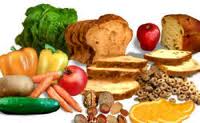
It is a good idea to try to eat more fibre because most people in Ireland don’t have enough fibre in their diets. Insoluble fibre helps prevent constipation, and soluble fibre may help to reduce the amount of cholesterol in the blood.
Wholegrain varieties of starchy foods, such as wholemeal bread, wholegrain breakfast cereals, brown rice and wholegrain pasta, are particularly good sources of insoluble fibre.
Brussels sprouts, potatoes, cabbage, and carrots are all good sources of fibre, and so are beans and pulses, such as red kidney beans, baked beans, broad beans, butter beans, green beans, chickpeas, green lentils and black-eyed beans. Dried fruit – such as figs, apricots, prunes and dates – are also a good choice. Or try eating pears, apples, cranberries, avocados, pomegranates and blackberries.
When you have plenty of fibre in your diet, you need to make sure that you drink plenty of fluids – at least six to eight glasses a day. It is especially important to have plenty of water if you are constipated because fluids will help to keep things moving! If you get constipated a lot, talk to your GP.
Tags: 5 a day, activity, calories, carbohydrate, carlow, drinking, fibre, fruit, healthy eating, kilkenny, nutrition, nutritional concepts, portion, starchy, vegetables, vitamins and minerals
Posted in General | Comments Off
Monday, January 17th, 2011
Many people find it difficult to tell the difference between what a dietitian and a nutritionist does. Nutritional Concepts was founded by Sabrina Doyle who is herself from the Carlow/Kilkenny area to provide the latest diet and nutrition information in a professional, friendly and innovative way. Nutritional Concepts hopes that this blog entry will explain the differences and help you to decide which service suits your dietary needs best.
Dietitian
Definition: A dietitian is a health professional who has university qualifications consisting of a 4-year Bachelor Degree in Nutrition and Dietetics or a 3-year Science Degree followed by a Master Degree in Nutrition and Dietetics, including a certain period of practical training in different hospital and community settings. Some dietitians also further their knowledge and skills by pursuing various Specialist Dietetic qualifications. Dietitian is an expert in prescribing therapeutic nutrition.
Regulation: All qualified Dietitians should have met national/international standards for professional legislation. The title “Dietitian” is protected by law in many countries such as Canada, USA, Australia, UK and Ireland.
Work: Dietitians can translate the science of nutrition into everyday information about food. They also have special skills in translating medical decisions related to food and health to inform the general public. Dietitians can work in both the hospital and community. They may work with people who have special dietary needs, inform the general public about nutrition, evaluate and improve treatments and educate clients, doctors, nurses, health professionals and community groups. They undertake the practical application of nutrition with both individuals and population groups to promote well-being and to prevent nutrition related problems. They are also involved in the diagnoses and dietary treatment of many diseases, such as food allergies, kidney disease, diabetes, cancer, etc.
Your safety: Registered Dietitians are members of one or more professional bodies, and therefore they are held accountable for their conduct and the care they provide. Because of this, the reliability and safety of their professional advice and care are ensured.
Nutritionist
Definition and Regulation: A nutritionist is a non-accredited title that may apply to somebody who has done a short course in nutrition or who has given themselves this title. The term Nutritionist is not protected by law in almost all countries so people with different levels of and knowledge can call themselves a “Nutritionist”.
Work: There are also qualified nutritionists, who are people who have completed University Degrees in Food Science, Human Nutrition, Food and Nutrition, or Food Technology. They are also called Food Scientists. University qualified Nutritionists and Food Scientists normally work for food manufacturers, retailed businesses, in research and public health promotion. Some may work as Dietitian Assistants or Food Journalists. Nutritionists do not have any professional practical training, and therefore they should not be involved in the diagnosis and dietary treatment of any diseases.
Your safety: Since the title ‘nutritionist’ has been used by many unqualified people to describe their involvement in food and nutrition related practice, you should be careful when choosing a qualified nutritional professional.
Tags: carlow, diet, dietitian, healthy eating, kilkenny, lose weight, nutrition, nutritional concepts, nutritionist
Posted in General | Comments Off
Monday, November 29th, 2010
Squash and chilli soup
- 1 medium butternut squash, peeled and cut into 1” cubes
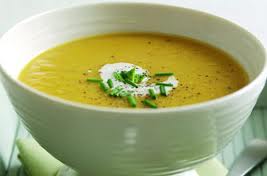
- 1 onion, peeled and finely chopped
- 1 red chilli, cored, deseeded and finely chopped
- 1 tin coconut milk
- Vegetable stock
- Olive oil
- Freshly ground salt and pepper
Sauté the squash, onion and chilli in a little oil for a few minutes then cover and leave over a low heat to sweat gently for 10 minutes. Add the coconut milk and enough stock to cover the vegetables. Bring to the boil and cover. Simmer gently for about 30 minutes or until the squash is tender. Season generously and whizz in a blender until smooth.
Bacon and lentil soup
- 6 oz lentils
- 2½ pints stock
- 1 clove garlic, peeled and finely chopped
- Freshly ground pepper
- 7 oz bacon rashers, finely chopped
- Small can tomatoes
- 1 large onion, peeled and finely chopped
- 1lb potatoes, peeled and diced
- 2 tablespoons lemon juice
Wash the lentils before placing them in a saucepan with the stock, garlic, pepper, bacon, tomatoes and onion. Bring to the boil, cover and simmer gently for about 1 hour or until the lentils and bacon are soft. Add the potatoes and cook for another 20 minutes. Whizz in a blender. Add the lemon juice and check the seasoning. Serve hot garnished with crispy fried bacon or grated cheese.
Tags: carlow, chilli, diet, healthy eating, kilkenny, lentil, nutrition, soup, squash, tasty, vegetables, winter
Posted in Recipes | Comments Off











